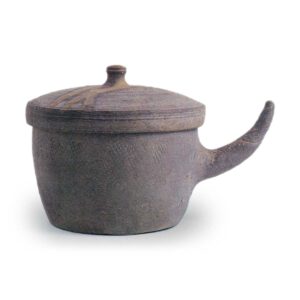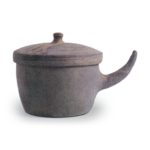
6th century.
Overall height 9.7cm, lid diameter 10.3cm, mouth diameter 9.1cm, body diameter 10.0cm, bottom diameter 7.9cm.
Covered jars or vessels with a single square handle attached to the body are common in Kinai earthenware of the early 6th century, but are extremely rare in Sue ware. This type of jar with a square base or a square lid was a new vessel form introduced from Korea with the introduction of Sue ware production techniques, which probably had an influence on Jiushi ware. Rarely, a red-fired earthenware jar with a square lid was found in a Silla burial mound.
The lid is made of a dense grayish-white clay base, rolled up with clay cords, and molded with a lattice pattern. The top of the lid is decorated with a three-striped hidasuki across the cord. This is a very Silla-like vessel, but as this type of material and molding has been occasionally excavated in Mie Prefecture, we would like to think that it was made in Japan, even though there are strong foreign elements in it. It is thin and elaborate.








